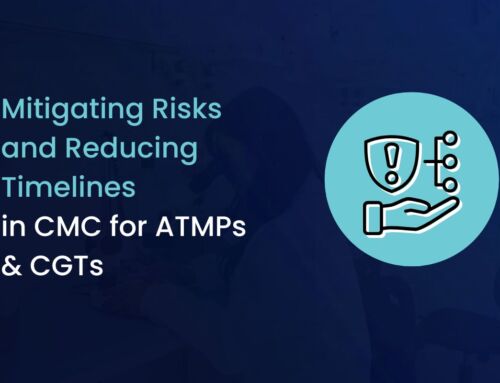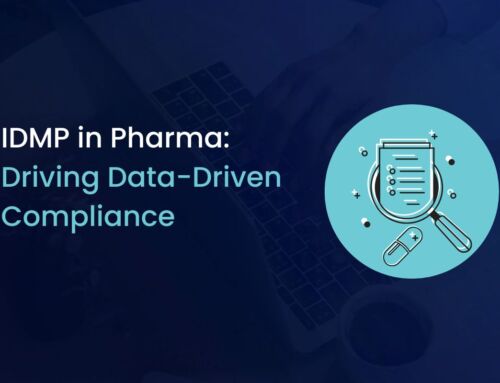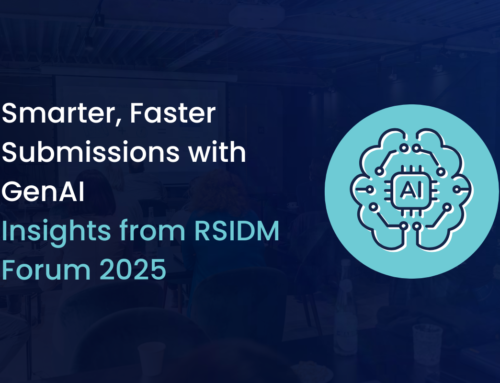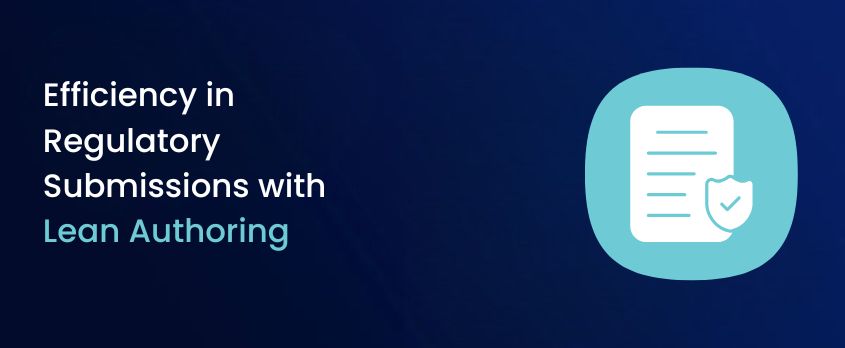
Efficiency in Regulatory Submissions with Lean Authoring
Learn How To Save Time, Improve Compliance and Streamline Global Regulatory Documentation Processes
In the complex landscape of regulatory submissions, efficiency is paramount. Lean authoring offers a transformative approach to streamline submissions, reduce redundancy, and improve compliance outcomes. By emphasizing clarity and structured documentation, this method is helping organizations tackle the evolving regulatory challenges for pharmaceuticals, medical devices, and beyond. This blog draws insights from our recent webinar, where industry experts Hans and Marloes shed light on the principles and real-world applications of lean authoring.
The Role of Regulatory Submissions: A Bigger Picture
In essence, regulatory submissions document the proof that a product is consistently manufactured, high in quality, and offers a favorable safety-efficacy profile for its intended patient population. This involves compiling data from non-clinical and clinical studies, manufacturing processes, and quality control systems. Furthermore, submissions must be updated regularly to reflect new findings or changes in manufacturing, ensuring that health authorities are consistently informed throughout the product lifecycle.
Using too many narratives while compiling submissions leads to inefficiencies, inconsistencies, and lengthy review timelines. Lean authoring addresses these pain points by streamlining documentation processes and creating reusable, modular documents tailored to specific regulatory requirements.
What Is Lean Authoring?
Lean authoring is a methodology that prioritizes efficiency, clarity, and reusability in regulatory documentation. It simplifies the process of preparing submissions by focusing on essential information while eliminating redundancies and unnecessary details.
Key principles of lean authoring include:
- Separating Content from Context: Content such as core technical data is included in modules 2 to 5, while contextual details (e.g., submission region, product-specific details) are confined to module 1. This separation ensures that content remains consistent and reusable across multiple submissions.
- Creating Reusable Documents: By developing modular, standalone documents, organizations can reuse content across different regions and submission types without significant modifications.
- Optimizing Document Granularity: Documents are divided into fine-grained components that can be re-used without re-work for the purpose of other submissions.
- Reducing Cross-Referencing: Overuse of cross-references and hyperlinks can lead to confusion and errors, especially when new documents get added to an existing dossier. Lean authoring minimizes the need for such references by ensuring that information is presented clearly and consistently.
These principles not only improve the efficiency of the authoring process but also facilitate faster reviews by health authorities, as documents are more concise and easier to navigate.
The Case for Structured Data in Submissions
Traditional regulatory submissions often involve transferring large narrative documents in PDF format. Health authorities then extract and analyze this information, introducing inefficiencies and potential errors. Lean authoring, combined with structured data approaches, offers a revolutionary alternative:
- Shared Data Platforms: Instead of transferring static documents, eventually organizations might be able to collaborate with health authorities through secure cloud-based platforms (several initatives are currently steered in this direction). These platforms allow real-time access to lifecycle-managed data, eliminating the need for repetitive submissions.
- Auto-Populated Documents: Structured templates draw directly from databases, ensuring accuracy and consistency while significantly reducing the time required for manual data entry.
- Tabular Formats: Presenting information in tables rather than narrative text reduces linguistic ambiguities, making it easier for reviewers to interpret the data accurately.
Global initiatives like the FDA’s PQCMC and ICH M4Q revisions are already pushing for such database-driven regulatory submissions. These initiatives aim to replace traditional document submissions with streamlined data exchanges, setting a new standard for efficiency in the regulatory space.
Benefits of Lean Authoring
Organizations that adopt lean authoring principles can unlock significant benefits across various stages of the regulatory process:
- Time Savings: Lean authoring reduces the time required to author, review, and publish regulatory documents by eliminating unnecessary content and streamlining workflows.
- Enhanced Consistency: By using modular, reusable documents, organizations can minimize inconsistencies and ensure uniformity across submissions.
- Cost Efficiency: Streamlined processes translate into lower compliance costs, allowing organizations to allocate resources more effectively.
- Improved Collaboration: Shared templates and structured formats facilitate better communication between stakeholders, including regulatory teams, health authorities, and other partners.
- Faster Approvals: Concise and well-organized documentation accelerates the review process, leading to quicker regulatory approvals and market access.
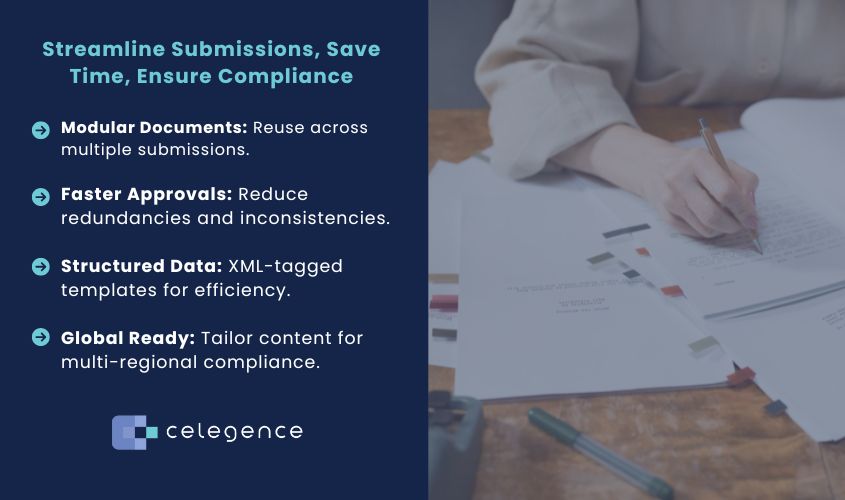
Celegence’s Role in Lean Authoring
At Celegence, we understand the challenges of regulatory submissions and have pioneered the use of lean authoring principles to address these complexities. As a tech-enabled regulatory solutions provider, we integrate advanced tools and best practices to optimize the submission process.
Our proprietary solutions, such as Dosscriber™, empower clients to:
- Streamlining Regulatory Submissions: By leveraging eCTD-ready templates and regulatory expertise, Dosscriber™ enables efficient authoring with reduced risk of major or critical queries during submissions.
- Facilitating Structured Documentation: Incorporating XML-tagged templates, Dosscriber™ ensures that information is organized and readily extractable, aligning with best practices for regulatory compliance.
- Supporting Lean Authoring Principles: With Dosscriber™, clients can create modular, standalone documents that are reusable across multiple submissions, reducing redundancy and improving submission efficiency.
These solutions, combined with our expertise, enable clients to achieve faster approvals and maintain compliance with confidence.
Conclusion
Lean authoring represents a paradigm shift in regulatory submissions, moving away from traditional document-heavy processes toward streamlined, data-driven methodologies. By adopting these principles, organizations can reduce redundancies, enhance consistency, and achieve faster approvals while ensuring compliance with regulatory standards.
At Celegence, we are committed to helping our clients navigate this transformation. To learn more about lean authoring and its benefits, download our Lean Authoring Checklist and watch the full webinar recording for an in-depth discussion.
